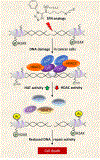Heterocyclic Analogs of Sulforaphane Trigger DNA Damage and Impede DNA Repair in Colon Cancer Cells: Interplay of HATs and HDACs
- PMID: 29924908
- PMCID: PMC6553464
- DOI: 10.1002/mnfr.201800228
Heterocyclic Analogs of Sulforaphane Trigger DNA Damage and Impede DNA Repair in Colon Cancer Cells: Interplay of HATs and HDACs
Abstract
Scope: DNA repair inhibitors have broad clinical applications in tumor types with DNA repair defects, including colorectal cancer (CRC). Structural analogs of the anticancer agent sulforaphane (SFN) were investigated as modifiers of histone deacetylase (HDAC) and histone acetyltransferase (HAT) activity, and for effects on DNA damage/repair pertinent to human CRC.
Methods and results: In the polyposis in rat colon (Pirc) model, single oral administration of SFN and structurally related long-chain isothiocyanates (ITCs) decreased histone deacetylase 3 (HDAC3) expression and increased pH2AX levels markedly in adenomatous colon polyps, extending prior observations on HDAC3 inhibition/turnover in cell-based assays. Colon cancer cells at a high initial plating density had diminished cytotoxicity from SFN, whereas novel tetrazole-containing heterocyclic analogs of SFN retained their efficacy. The potent SFN analogs triggered DNA damage, cell cycle arrest, apoptosis, and loss of a key DNA repair regulator, C-terminal binding protein (CtBP) interacting protein (CtIP). These SFN analogs also altered HAT/HDAC activities and histone acetylation status, lowered the expression of HDAC3, P300/CBP-associated factor (PCAF) and lysine acetyltransferase 2A (KAT2A/GCN5), and attenuated homologous recombination (HR)/non-homologous end joining (NHEJ) repair activities in colon cancer cells.
Conclusion: Novel tetrazole-containing heterocyclic analogs of SFN provide a new avenue for chemosensitization in colon cancer cells via modulation of HAT/HDAC activities and associated DNA damage/repair signaling pathways.
Keywords: C-terminal binding protein (CtBP) interacting protein; DNA damage; DNA repair; colon cancer; histone acetyltransferase; histone deacetylase; sulforaphane analogs.
© 2018 WILEY-VCH Verlag GmbH & Co. KGaA, Weinheim.
Conflict of interest statement
Conflict of Interest
The authors declare no conflict of interest.
Figures







Similar articles
-
HDAC turnover, CtIP acetylation and dysregulated DNA damage signaling in colon cancer cells treated with sulforaphane and related dietary isothiocyanates.Epigenetics. 2013 Jun;8(6):612-23. doi: 10.4161/epi.24710. Epub 2013 Apr 26. Epigenetics. 2013. PMID: 23770684 Free PMC article.
-
Histone deacetylase turnover and recovery in sulforaphane-treated colon cancer cells: competing actions of 14-3-3 and Pin1 in HDAC3/SMRT corepressor complex dissociation/reassembly.Mol Cancer. 2011 May 30;10:68. doi: 10.1186/1476-4598-10-68. Mol Cancer. 2011. PMID: 21624135 Free PMC article.
-
The impact of cruciferous vegetable isothiocyanates on histone acetylation and histone phosphorylation in bladder cancer.J Proteomics. 2017 Mar 6;156:94-103. doi: 10.1016/j.jprot.2017.01.013. Epub 2017 Jan 27. J Proteomics. 2017. PMID: 28132875 Free PMC article.
-
Epigenetic impact of dietary isothiocyanates in cancer chemoprevention.Curr Opin Clin Nutr Metab Care. 2013 Jul;16(4):405-10. doi: 10.1097/MCO.0b013e328362014e. Curr Opin Clin Nutr Metab Care. 2013. PMID: 23657153 Review.
-
Modulation of histone deacetylase activity by dietary isothiocyanates and allyl sulfides: studies with sulforaphane and garlic organosulfur compounds.Environ Mol Mutagen. 2009 Apr;50(3):213-21. doi: 10.1002/em.20454. Environ Mol Mutagen. 2009. PMID: 19197985 Free PMC article. Review.
Cited by
-
Benzyl and phenethyl isothiocyanates as promising epigenetic drug compounds by modulating histone acetylation and methylation marks in malignant melanoma.Invest New Drugs. 2021 Dec;39(6):1460-1468. doi: 10.1007/s10637-021-01127-0. Epub 2021 May 8. Invest New Drugs. 2021. PMID: 33963962
-
Downregulation of P300/CBP-Associated Factor Attenuates Myocardial Ischemia-Reperfusion Injury Via Inhibiting Autophagy.Int J Med Sci. 2020 May 18;17(9):1196-1206. doi: 10.7150/ijms.44604. eCollection 2020. Int J Med Sci. 2020. PMID: 32547315 Free PMC article.
-
Metabolic Fate of Dietary Glucosinolates and Their Metabolites: A Role for the Microbiome.Front Nutr. 2021 Sep 22;8:748433. doi: 10.3389/fnut.2021.748433. eCollection 2021. Front Nutr. 2021. PMID: 34631775 Free PMC article. Review.
-
Cruciferous vegetables as a treasure of functional foods bioactive compounds: Targeting p53 family in gastrointestinal tract and associated cancers.Front Nutr. 2022 Aug 4;9:951935. doi: 10.3389/fnut.2022.951935. eCollection 2022. Front Nutr. 2022. PMID: 35990357 Free PMC article. Review.
-
A recent overview on sulforaphane as a dietary epigenetic modulator.EXCLI J. 2020 Jan 15;19:131-134. doi: 10.17179/excli2019-2039. eCollection 2020. EXCLI J. 2020. PMID: 32194360 Free PMC article. No abstract available.
References
-
- American Cancer Society. Cancer Facts & Figures 2018. Atlanta, Ga: American Cancer Society, 2018. Retrieved from https://www.cancer.org/cancer/colon-rectal-cancer/about/key-statistics.html
-
- Lord CJ, Ashworth A, Curr. Opin. Pharmacol. 2008, 8, 363. - PubMed
Publication types
MeSH terms
Substances
Grants and funding
LinkOut - more resources
Full Text Sources
Other Literature Sources
Molecular Biology Databases
Research Materials
Miscellaneous

